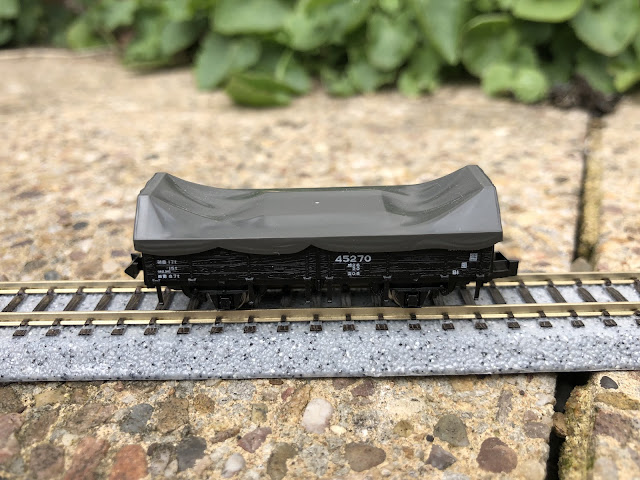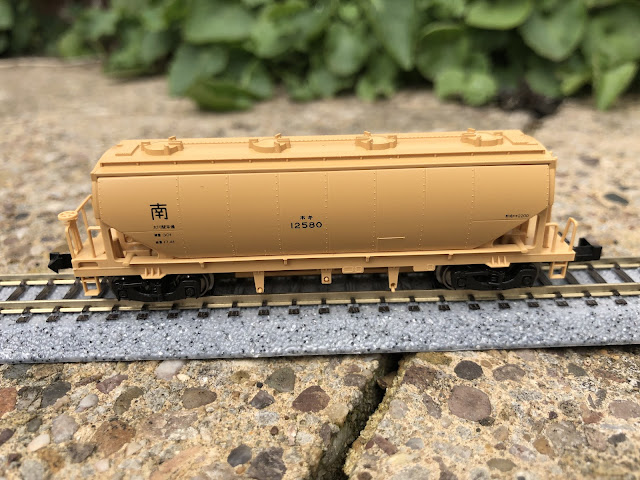Kato currently produce several starter packs of coaches or wagons that provide an inexpensive way to build up your rolling stock collection. The coaches or wagons are carefully selected to be appropriate to quite a broad time frame. The freight car pack, 10-033, contains six different models including a brake van (caboose) with working taillights. It was first released in 2019, then re-released in 2023. As far as I can tell, the two releases are identical, right down to the running numbers on the wagons.
Background
Although Japan has an extensive railway network, most of the trains are passenger trains. Less than 1% of the freight movements within Japan go by rail. The volume of freight traffic in absolute terms is substantial, over 26 million tons in 2023, but to put this in context, across an equivalent period in the UK, almost 70 million tons of freight was carried.
Much of the freight transported on Japanese railways today is containerised, but in the past a wide variety of freight cars could be seen. As was the case elsewhere in the world, pick-up goods trains declined through the latter half of the twentieth century, being replaced with trains consisting of a single commodity in wagons capable of running at high speed. Usually, these trains consist of raw materials such as oil or grain, rather than finished goods. One problem is that freight trains have to run on the slower Cape-gauge lines rather than the high speed standard-gauge (or Shinkansen) lines which hampers reliability and efficiency. Japanese cities also tend to be built on the coast which makes shipping a more economical way to send bulk commodities from point to point.
Nonetheless, Japanese freight services are interesting and attractive to modellers. While the most authentic approach might be to focus on container trains, the classic mixed goods train is appealing. That's where this freight car pack comes in!
Kato Freight Car Park (10-033)
- Waki 5000 bogie box car
- Tora 45000 two-axle open wagon with removeable tarpaulin
- Hoki 2200 bogie grain hopper
- Koki 5500 bogie container flat with containers
- Re 12000 two-axle refrigerated car
- Yo 5000 two-axle brake van
- Optional dummy coupler for the brake van
Waki 5000 bogie box cars were in service between 1965 and 2002 and featured sliding doors on the sides that allowed palleted loads to be quickly loaded and unloaded. All sorts of goods could be found on these wagons and they were very widely used across the network. They could carry up to 30 tons of cargo and were designed to operate at quite high speeds, up to 85 km/h. The model runs smoothly and looks quite nice, though the colour scheme isn't very interesting.
The Tora 45000 is a two-axle open wagon of a type built in large numbers between 1962 and 1963. Most have been scrapped, but a few remain in use, and some have even been converted into open passenger cars for heritage lines! Although the model looks rather plain in standard freight black livery, it features simulated wooden grain on the planks, neatly applied lettering, and a removeable tarpaulin that means the model can be operated open or covered as you prefer.
Conclusion
For an RRP of 7,150 Yen (about £37) and widely sold in Japan for well under that, this wagon pack is an absolute bargain when compared to some of rolling stock sold in other countries. The actual saving compared to buying the wagons separately is negligble though (by my reckoning, the RRP for these wagons is 935 + 990 + 990 + 550 + 935 + 1,980 = 6380 Yen, which is about what the set goes for at the usual online retailers).
But while the pack is definitely good value, there are compromises here. The two-axle wagons, in particular, are basic models with no separately fitted details and dull colour schemes. The grain hopper is a lovely model, but the detailing around the platforms at each end, such as the hand rails, are quite coarse. Similarly, while the container flat does the job, the single-piece container load needs some weathering to look convincing. Kato (and Tomix) do produce higher higher-spec Koki container flats with much more detailing as well as properly removeable containers, but these cost a lot more -- Kato #8059 costs 3,520 Yen (about £18).
Although Kato have selected prototypes that were in use across a long period of time, and might be seen behind steam, diesel, or electric locomotives of various types, whether they'd actually all be running in the same train is open to debate. Still, you could realistically stick the smaller wagons behind a tank engine like a C11 or C12 without embarassement, while the hopper and container flat look really nice behind a diesel or electric locomotive in a more modern setting.
The wagons can also be upgraded with either manual buckeye coupings (Kato #11-702) or magnetic couplings (Kato #11-711) for more realism. The magnetic couplings, together with the decoupling Unitrack piece (Kato #20-032) would allow for hands-free coupling and decoupling, would make this a fun pack for shunting puzzle layouts.
On balance, this is probably a pack for the newcomer to Japanese model railroading looking to just run some trains without worrying too much about realism or detailing. None of the wagons is useless, and with additional wagons added as the modeller gets a better idea of what they like to run, there are wagons here that will always remain useful.










No comments:
Post a Comment